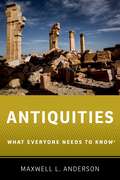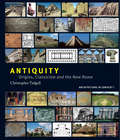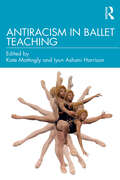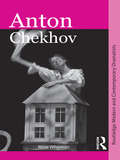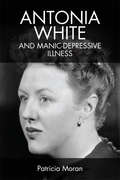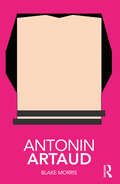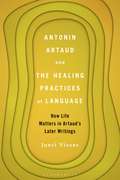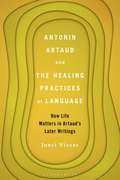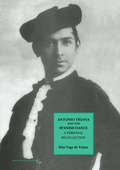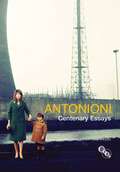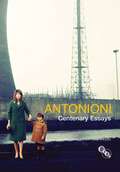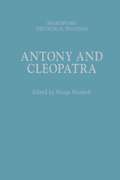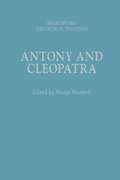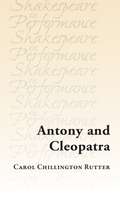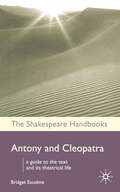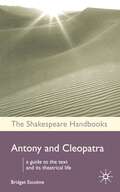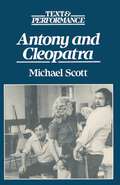- Table View
- List View
Antiquities: What Everyone Needs to Know® (What Everyone Needs To Know®)
by Maxwell L. AndersonThe destruction of ancient monuments and artworks by the Taliban in Afghanistan and the Islamic State in Iraq and Syria has shocked observers worldwide. Yet iconoclastic erasures of the past date back at least to the mid-1300s BCE, during the Amarna Period of ancient Egypt's 18th dynasty. Far more damage to the past has been inflicted by natural disasters, looters, and public works. Art historian Maxwell Anderson's Antiquities: What Everyone Needs to Know® analyzes continuing threats to our heritage, and offers a balanced account of treaties and laws governing the circulation of objects; the history of collecting antiquities; how forgeries are made and detected; how authentic works are documented, stored, dispersed, and displayed; the politics of sending antiquities back to their countries of origin; and the outlook for an expanded legal market. Anderson provides a summary of challenges ahead, including the future of underwater archaeology, the use of drones, remote sensing, and how invisible markings on antiquities will allow them to be traced. Written in question-and-answer format, the book equips readers with a nuanced understanding of the legal, practical, and moral choices that face us all when confronting antiquities in a museum gallery, shop window, or for sale on the Internet.
ANTIQUITIES WENK C: What Everyone Needs to Know® (What Everyone Needs To Know®)
by Maxwell L. AndersonThe destruction of ancient monuments and artworks by the Taliban in Afghanistan and the Islamic State in Iraq and Syria has shocked observers worldwide. Yet iconoclastic erasures of the past date back at least to the mid-1300s BCE, during the Amarna Period of ancient Egypt's 18th dynasty. Far more damage to the past has been inflicted by natural disasters, looters, and public works. Art historian Maxwell Anderson's Antiquities: What Everyone Needs to Know® analyzes continuing threats to our heritage, and offers a balanced account of treaties and laws governing the circulation of objects; the history of collecting antiquities; how forgeries are made and detected; how authentic works are documented, stored, dispersed, and displayed; the politics of sending antiquities back to their countries of origin; and the outlook for an expanded legal market. Anderson provides a summary of challenges ahead, including the future of underwater archaeology, the use of drones, remote sensing, and how invisible markings on antiquities will allow them to be traced. Written in question-and-answer format, the book equips readers with a nuanced understanding of the legal, practical, and moral choices that face us all when confronting antiquities in a museum gallery, shop window, or for sale on the Internet.
Antiquity: Origins, Classicism and The New Rome
by Christopher TadgellThe first in a new series of five books describing and illustrating the seminal architectural traditions of the world, Antiquity traces architectural history from its very beginnings until the time when the traditions that shape today’s environments began to flourish. More than a catalogue of buildings, in this work Tadgell provides their political, technological, social and cultural contexts and explores architecture, not only as the development of form and space but as an expression of the civilization within which it evolves. The buildings are analyzed and illustrated with over 1200 colour photographs and 400 drawings while the societies that produced them are brought to life through a broad selection of their artefacts.
Antiquity: Origins, Classicism and The New Rome
by Christopher TadgellThe first in a new series of five books describing and illustrating the seminal architectural traditions of the world, Antiquity traces architectural history from its very beginnings until the time when the traditions that shape today’s environments began to flourish. More than a catalogue of buildings, in this work Tadgell provides their political, technological, social and cultural contexts and explores architecture, not only as the development of form and space but as an expression of the civilization within which it evolves. The buildings are analyzed and illustrated with over 1200 colour photographs and 400 drawings while the societies that produced them are brought to life through a broad selection of their artefacts.
Antiracism in Ballet Teaching
by Kate Mattingly Iyun Ashani HarrisonThis new collection of essays and interviews assembles research on teaching methods, choreographic processes, and archival material that challenges systemic exclusions and provides practitioners with accessible steps to creating more equitable teaching environments, curricula, classes, and artistic settings. Antiracism in Ballet Teaching gives readers a wealth of options for addressing and dismantling racialized biases in ballet teaching, as well as in approaches to leadership and choreography. Chapters are organized into three sections - Identities, Pedagogies, and Futurities - that illuminate evolving approaches to choreographing and teaching ballet, shine light on artists, teachers, and dancers who are lesser known/less visible in a racialized canon, and amplify the importance of holistic practices that integrate ballet history with technique and choreography. Chapter authors include award-winning studio owners, as well as acclaimed choreographers, educators, and scholars. The collection ends with interviews featuring ballet company directors (Robert Garland and Alonzo King), world-renowned scholars (Clare Croft, Thomas F. DeFrantz, Brenda Dixon Gottschild), sought-after choreographers (Jennifer Archibald and Claudia Schreier), and beloved educators (Keesha Beckford, Tai Jimenez, and Endalyn Taylor). This is an essential resource for anyone teaching or learning to teach ballet in the Twenty First Century.
Antiracism in Ballet Teaching
by Kate Mattingly Iyun Ashani HarrisonThis new collection of essays and interviews assembles research on teaching methods, choreographic processes, and archival material that challenges systemic exclusions and provides practitioners with accessible steps to creating more equitable teaching environments, curricula, classes, and artistic settings. Antiracism in Ballet Teaching gives readers a wealth of options for addressing and dismantling racialized biases in ballet teaching, as well as in approaches to leadership and choreography. Chapters are organized into three sections - Identities, Pedagogies, and Futurities - that illuminate evolving approaches to choreographing and teaching ballet, shine light on artists, teachers, and dancers who are lesser known/less visible in a racialized canon, and amplify the importance of holistic practices that integrate ballet history with technique and choreography. Chapter authors include award-winning studio owners, as well as acclaimed choreographers, educators, and scholars. The collection ends with interviews featuring ballet company directors (Robert Garland and Alonzo King), world-renowned scholars (Clare Croft, Thomas F. DeFrantz, Brenda Dixon Gottschild), sought-after choreographers (Jennifer Archibald and Claudia Schreier), and beloved educators (Keesha Beckford, Tai Jimenez, and Endalyn Taylor). This is an essential resource for anyone teaching or learning to teach ballet in the Twenty First Century.
Anton Chekhov (Routledge Modern and Contemporary Dramatists)
by Rose WhymanAnton Chekhov offers a critical introduction to the plays and productions of this canonical playwright, examining the genius of Chekhov's writing, theatrical representation and dramatic philosophy. Emphasising Chekhov’s continued relevance and his mastery of the tragicomic, Rose Whyman provides an insightful assessment of his life and work. All of Chekhov’s major dramas are analysed, in addition to his vaudevilles, one-act plays and stories. The works are studied in relation to traditional criticism and more recent theoretical and cultural standpoints, including cultural materialism, philosophy and gender studies. Analysis of key historical and recent productions, display the development of the drama, as well as the playwright’s continued appeal. Anton Chekhov provides readers with an accessible comparative study of the relationship between Chekhov's life, work and ideological thought.
Anton Chekhov (Routledge Modern and Contemporary Dramatists)
by Rose WhymanAnton Chekhov offers a critical introduction to the plays and productions of this canonical playwright, examining the genius of Chekhov's writing, theatrical representation and dramatic philosophy. Emphasising Chekhov’s continued relevance and his mastery of the tragicomic, Rose Whyman provides an insightful assessment of his life and work. All of Chekhov’s major dramas are analysed, in addition to his vaudevilles, one-act plays and stories. The works are studied in relation to traditional criticism and more recent theoretical and cultural standpoints, including cultural materialism, philosophy and gender studies. Analysis of key historical and recent productions, display the development of the drama, as well as the playwright’s continued appeal. Anton Chekhov provides readers with an accessible comparative study of the relationship between Chekhov's life, work and ideological thought.
Antonia White and Manic-Depressive Illness
by Patricia MoranExamines the politics of female ship in relation to contemporary documentary practices
Antonia White and Manic-Depressive Illness
by Patricia MoranApplies complex Deleuzian thought to the quintessential French auteur
Antonin Artaud (Routledge Performance Practitioners)
by Blake MorrisRoutledge Performance Practitioners is a series of introductory guides to the key theatre-makers of the last century. Each volume explains the background to and the work of one of the major influences on twentieth- and twenty-first-century performance. Antonin Artaud was an active theatre-maker and theorist whose ideas reshaped contemporary approaches to performance. This is the first book to combine an overview of Artaud’s life with a focus on his work as an actor and director; an analysis of his key theories, including the Theatre of Cruelty and the double; a consideration of his work as a director at the Théâtre Alfred Jarry and his production of Strindberg’s A Dream Play; and a series of practical exercises to develop an approach to theatre based on Artaud’s key ideas. As a first step towards critical understanding and as an initial exploration before going on to further, primary research, Routledge Performance Practitioners are unbeatable value for today’s student.
Antonin Artaud (Routledge Performance Practitioners)
by Blake MorrisRoutledge Performance Practitioners is a series of introductory guides to the key theatre-makers of the last century. Each volume explains the background to and the work of one of the major influences on twentieth- and twenty-first-century performance. Antonin Artaud was an active theatre-maker and theorist whose ideas reshaped contemporary approaches to performance. This is the first book to combine an overview of Artaud’s life with a focus on his work as an actor and director; an analysis of his key theories, including the Theatre of Cruelty and the double; a consideration of his work as a director at the Théâtre Alfred Jarry and his production of Strindberg’s A Dream Play; and a series of practical exercises to develop an approach to theatre based on Artaud’s key ideas. As a first step towards critical understanding and as an initial exploration before going on to further, primary research, Routledge Performance Practitioners are unbeatable value for today’s student.
Antonin Artaud and the Healing Practices of Language: How Life Matters in Artaud’s Later Writings
by Joeri VisserThe life of Antonin Artaud (1896-1948) was tormented by physical and mental illnesses. Already in his earlier works, Artaud tried to express his physical and mental suffering, but perceived, in describing his feelings, the obstructive and illness-inducing role of language. This is the first book written in English that analyses the role of a healing language with which Artaud engaged in his later writings. Joeri Visser guides us through the years in which Artaud suffered increasingly from mental instability and considered the act of writing his only means of survival. In doing so, Visser unfolds a literary and a philosophical analysis of how language and life work together and how a creative play with language can help us to reengage sustainably with the joyous as well as the terrible forces of life.
Antonin Artaud and the Healing Practices of Language: How Life Matters in Artaud’s Later Writings
by Joeri VisserThe life of Antonin Artaud (1896-1948) was tormented by physical and mental illnesses. Already in his earlier works, Artaud tried to express his physical and mental suffering, but perceived, in describing his feelings, the obstructive and illness-inducing role of language. This is the first book written in English that analyses the role of a healing language with which Artaud engaged in his later writings. Joeri Visser guides us through the years in which Artaud suffered increasingly from mental instability and considered the act of writing his only means of survival. In doing so, Visser unfolds a literary and a philosophical analysis of how language and life work together and how a creative play with language can help us to reengage sustainably with the joyous as well as the terrible forces of life.
Antonio Triana and the Spanish Dance: A Personal Recollection (Choreography and Dance Studies Series)
by Rita Vega de TrianaThis book also traces the evolution of the Spanish Dance technique, marked as it is by a turbulent history. Antonio Triana was a dancer of mature artistry, dignity and power. His physical and technical achievements went beyond what is generally known about Spanish Dance. His dance presented the essence of the Spanish character and, in his choreography, he used his traditional background for his brilliant inspirations. He partnered the legendary La Argentinita, Pilar Lopez and Carmen Amaya with spirit and gallantry. Over the years he developed a very distinct method of teaching and he became one of the foremost Spanish Flamenco dancers and teachers of his time. Rita Vega de Triana formed the Triana Ballet Español with her late husband. She currently teaches Hispanic dance and related subjects at the University of Texas at El Paso and directs her own school as well as performing around the United States as a guest artist and choreographer.
Antonio Triana and the Spanish Dance: A Personal Recollection (Choreography and Dance Studies Series #Vol. 6)
by Rita Vega de TrianaThis book also traces the evolution of the Spanish Dance technique, marked as it is by a turbulent history. Antonio Triana was a dancer of mature artistry, dignity and power. His physical and technical achievements went beyond what is generally known about Spanish Dance. His dance presented the essence of the Spanish character and, in his choreography, he used his traditional background for his brilliant inspirations. He partnered the legendary La Argentinita, Pilar Lopez and Carmen Amaya with spirit and gallantry. Over the years he developed a very distinct method of teaching and he became one of the foremost Spanish Flamenco dancers and teachers of his time. Rita Vega de Triana formed the Triana Ballet Español with her late husband. She currently teaches Hispanic dance and related subjects at the University of Texas at El Paso and directs her own school as well as performing around the United States as a guest artist and choreographer.
Antonioni: Centenary Essays
by Laura Rascaroli John David RhodesThis collection of new essays by leading film scholarsaddresses Michelangelo Antonionias apre-eminent figure in European art cinema, explores his continuing influence and legacy, and engages with his ability to both interpret and shape ideas of modernity and modern cinema.
Antonioni: Centenary Essays
This collection of new essays by leading film scholarsaddresses Michelangelo Antonionias apre-eminent figure in European art cinema, explores his continuing influence and legacy, and engages with his ability to both interpret and shape ideas of modernity and modern cinema.
Antony and Cleopatra: Shakespeare: The Critical Tradition (Shakespeare: The Critical Tradition)
by Joseph Candido Professor Brian VickersThis new volume in the Shakespeare: The Critical Tradition series increases our knowledge of how Antony and Cleopatra has been received and understood by critics, editors and general readers. The volume provides, in separate sections, both critical opinions about the play across the centuries and an evaluation of their positions within and their impact on the reception of the play. The chronological arrangement of the text-excerpts engages the readers in a direct and unbiased dialogue, and the introduction offers a critical evaluation from a current stance, including modern theories and methods. This volume makes a major contribution to our understanding of the play and of the traditions of Shakespearean criticism surrounding it as they have developed from century to century.
Antony and Cleopatra: Shakespeare: The Critical Tradition (Shakespeare: The Critical Tradition)
by Joseph Candido Professor Brian VickersThis new volume in the Shakespeare: The Critical Tradition series increases our knowledge of how Antony and Cleopatra has been received and understood by critics, editors and general readers. The volume provides, in separate sections, both critical opinions about the play across the centuries and an evaluation of their positions within and their impact on the reception of the play. The chronological arrangement of the text-excerpts engages the readers in a direct and unbiased dialogue, and the introduction offers a critical evaluation from a current stance, including modern theories and methods. This volume makes a major contribution to our understanding of the play and of the traditions of Shakespearean criticism surrounding it as they have developed from century to century.
Antony and Cleopatra (Shakespeare in Performance)
by Carol Chillington RutterThis book writes a performance history of Antony and Cleopatra, Shakespeare’s most ambiguous play, from 1606 to the present. It observes the choices that actors, directors, designers, musicians and adapters have made each time they have brought the play’s thoughts on power, race, masculinity, regime change, exoticism, love, dotage and delinquency into alignment with a new present. Informed by close attention to theatre records – promptbooks, stage managers’ reports, reviews – it offers in-depth analyses of fifteen international productions by (among others) the Royal Shakespeare Company, Citizens Theatre Glasgow, Northern Broadsides, Berliner Ensemble and Toneelgroep Amsterdam. It ends seeing Shakespeare’s black Egyptian Queen Cleopatra – whited-out in performance for centuries – restored to the contemporary stage. Written in a lively and accessible style, this book will be of interest to students, academics, actors, directors and general readers alike.
Antony and Cleopatra (Shakespeare in Performance)
by Carol Chillington RutterThis book writes a performance history of Antony and Cleopatra, Shakespeare’s most ambiguous play, from 1606 to the present. It observes the choices that actors, directors, designers, musicians and adapters have made each time they have brought the play’s thoughts on power, race, masculinity, regime change, exoticism, love, dotage and delinquency into alignment with a new present. Informed by close attention to theatre records – promptbooks, stage managers’ reports, reviews – it offers in-depth analyses of fifteen international productions by (among others) the Royal Shakespeare Company, Citizens Theatre Glasgow, Northern Broadsides, Berliner Ensemble and Toneelgroep Amsterdam. It ends seeing Shakespeare’s black Egyptian Queen Cleopatra – whited-out in performance for centuries – restored to the contemporary stage. Written in a lively and accessible style, this book will be of interest to students, academics, actors, directors and general readers alike.
Antony and Cleopatra (Shakespeare Handbooks)
by Bridget EscolmeThis handbook offers a way in to reading Anthony and Cleopatra theatrically. Through analyses of key productions, an account of the historical conditions in which the play was first produced, and a scene-by-scene account of how the play might be approached in performance, this book focuses on the challenges of staging the notorious lovers.
Antony and Cleopatra (Shakespeare Handbooks)
by Bridget EscolmeThis handbook offers a way in to reading Anthony and Cleopatra theatrically. Through analyses of key productions, an account of the historical conditions in which the play was first produced, and a scene-by-scene account of how the play might be approached in performance, this book focuses on the challenges of staging the notorious lovers.
Antony and Cleopatra (Text and Performance)
by Michael ScottThis ebook is now available from Bloomsbury Academic. Bloomsbury Academic publish acclaimed resources for undergraduate and postgraduate courses across a broad range of subjects including Art & Visual Culture, Biblical Studies, Business & Management, Drama & Performance Studies, Economics, Education, Film & Media, History, Linguistics, Literary Studies, Philosophy, Politics & International Relations, Religious Studies, Social Work & Social Welfare, Study Skills and Theology. Visit bloomsbury.com for more information.
